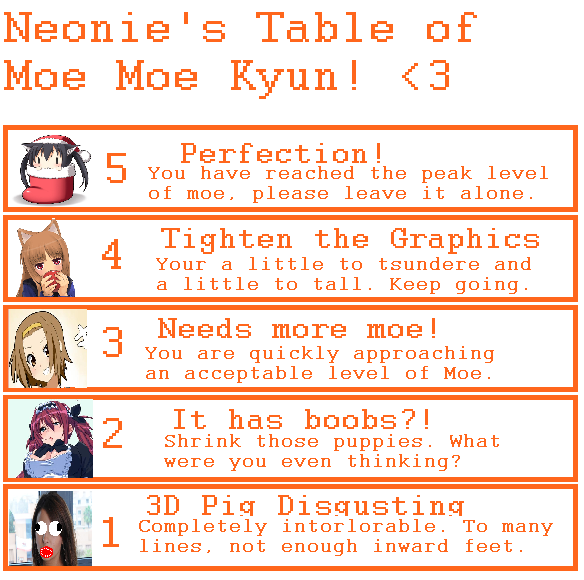*Please note that I actually heard this from someone else, but I don't remember who.
So the "Moe Scale" has only been attempted a few times. However, on both major occurrences I am aware of, they are very limited in scope. Sometimes, it can be quite difficult to place a character.
For example, take Japanator's moe scale:

This is far too generalized. Some characters can fit between two categories. In fact, using "moe moe kyun" in the title of this scale is ironic since Mio is frequently regarded as the most moe character of K-ON, yet has breasts that go boin. Additionally, some regard tsudere as the most moe characteristic a character can have! Also, real-life (3D) people can be moe too.

This second one I found on the Crunchyroll forums and I think is getting close to a usable scale. This scale includes "GAR", the opposite of moe, to give comparisons to. However, it's actually more vague than the Japanator scale in that there's no real indication of how to give characters the right level on the scale. It's mostly guesstimating, which isn't very helpful as you'll be arguing with yourself about putting characters between other characters.
This is where my moe scale comes in. It takes an actual quantifiable unit of measure, and applies it to moe. Incidentally, this led to creating my own unit of measure. More on that later.
But first, how do we measure with this scale. First, take a standard anime episode featuring the character due to be measured. This works best if the character is on screen for extended periods of time. You will struggle with minor characters, but if they talk for a while, this could also work.
Watch the episode up to when the chosen character is due to appear. Start a stopwatch at the moment the character appears for his/her/its extended appearance.
Now, this is crucial. Stop the stopwatch the moment you feel the urge to either hug the character or go "dawwwwww"(+/- any amount of "w"s). Round the number of seconds to the nearest second. You will now have the level of moe for this character.
In order to store and share this data, it is recommended to use the unit of measure "seconds 'till hugs" or sth for short. So, for a period of 10 seconds until the urge to hug arises, this would be displayed as "10sth". Note that I am using "hugs" rather than "dawww". This is because "second 'till dawww" would be abbreviated to "std" which could be interpreted as something different.
You may be thinking that this would only be valid for that one scene. You would indeed be right, however it does give a fair indication of the moe level of the character. For enhanced accuracy, it is recommended to apply this method to several scenes over various episodes, then take the average seconds 'till hugs.
I believe this method of measuring characters' moe level is more accurate and more fair than other ways. This way, you cannot argue with yourself regarding the placement of characters, and allows for a much larger range of characters, and can also be applied to real-life 3D people too with some slight modifications.
I hope that one day, my moe scale will become the standard in moe measuring across the world. In fact, one day, there could be a global database of people's moe scale measurements for characters which get averaged and we officially find the world's most moe character/person.
Coming soon: a blog post featuring my own moe scale'd characters...
Have a nice day,
Dr. Peter Shillito PHD
DISCLAIMER: I am not a doctor, I do not have a PHD and this article has no real scientific merit. I also do not have a patent pending on the idea as it wasn't my idea in the first place and I don't think I could patent it anyway. I do think it's an interesting idea with potential though. Let me know what you think!
No comments:
Post a Comment